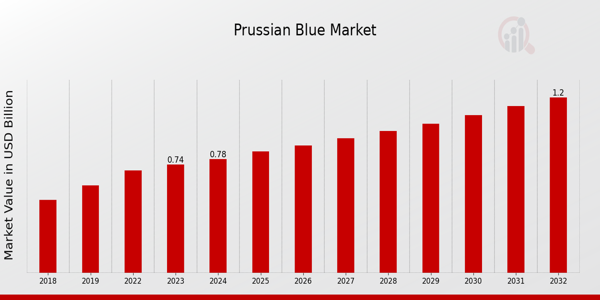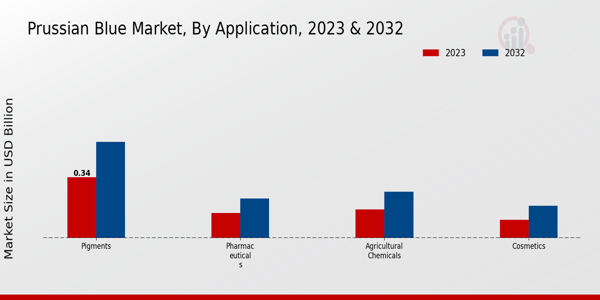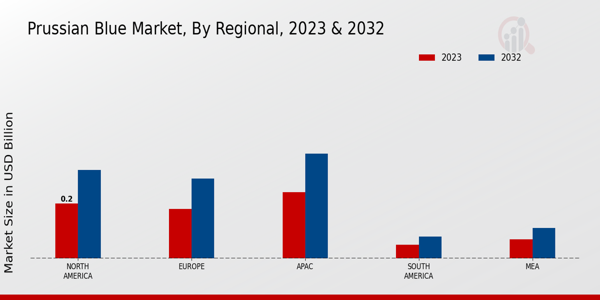Global Prussian Blue Market Overview
The Prussian Blue Market Size was estimated at 0.82 (USD Billion) in 2024. The Prussian Blue Market is expected to grow from 0.87 (USD Billion) in 2025 to 1.4 (USD Billion) by 2034. The Prussian Blue Market CAGR (growth rate) is expected to be around 5.50% during the forecast period (2025 - 2034).
Key Prussian Blue Market Trends Highlighted
The Prussian Blue Market is experiencing significant growth driven primarily by its increasing applications across various industries. Key market drivers include the demand for eco-friendly pigments in paints and coatings, as well as the rising interest in advanced applications such as medical imaging and drug delivery systems.
Moreover, the growing awareness of the harmful effects of synthetic dyes has pushed manufacturers to shift towards natural and safe alternatives, further propelling market expansion.
There are numerous opportunities to be explored within this market, particularly in the realm of sustainable development. As industries seek to reduce their environmental impact, the focus on sustainable and non-toxic materials creates a favorable climate for the adoption of Prussian Blue in various formulations.
The rise in renewable energy technologies, including solar cells and batteries, also presents new avenues for utilizing Prussian Blue, generating potential growth in the market. Trends in recent times reflect a shift towards innovation and research in the functionality of Prussian Blue.
Manufacturers are making strides in enhancing the quality and performance of Prussian Blue through improved synthesis techniques. This advancement not only improves its application efficiency but also expands its use in specialty chemical industries.
Additionally, collaborations between companies and research institutions are becoming more prevalent, aiming to explore new applications and enhance the material's properties.
Overall, the combination of industry drivers, emerging opportunities, and recent trends indicates a robust outlook for the Prussian Blue Market as it continues to adapt and evolve in response to market needs.

Source: Primary Research, Secondary Research, MRFR Database and Analyst Review
Prussian Blue Market Drivers
Increasing Demand for Prussian Blue in Medical Applications
One of the most significant drivers of growth in the Prussian Blue Market is the increasing demand for Prussian Blue in various medical applications. Prussian Blue is widely utilized as a medication for treating conditions such as radioactive cesium and thallium poisoning.
The rising prevalence of such poisoning cases, along with the need for effective therapeutic options, contributes to the growing interest in Prussian Blue. With advancements in medical research and the continuous exploration of its potential benefits, the demand for this compound in the healthcare sector is expected to escalate.
Furthermore, the pharmaceutical industry is investigating the broader applications of Prussian Blue, leading to innovations in drug formulations, which is anticipated to boost the overall market for Prussian Blue.
The incorporation of Prussian Blue in diagnostics and imaging techniques, as well as its utility in treating other health-related issues, underlines its importance and enhances its acceptance among medical professionals. Such developments will likely expand the volume and range of applications that Prussian Blue can serve, creating notable growth opportunities for the Prussian Blue Market.
Growth in the Paint and Coatings Industry
The expansion of the paint and coatings industry is a prominent driver influencing the Prussian Blue Market. Prussian Blue is valued for its remarkable pigmentation property, making it a key ingredient in high-quality paints, coatings, and inks.
As global infrastructure development and urbanization continue to rise, the demand for a wide array of paints and coatings increases, in which Prussian Blue plays an essential role, particularly in producing vibrant colors.
The push for eco-friendly and sustainable products is also driving manufacturers to explore natural pigments like Prussian Blue, further solidifying its position within this industry. Sustainable development goals necessitate the adoption of greener solutions, and Prussian Blue aligns with these goals as it is non-toxic and environmentally friendly, enhancing its appeal to consumers and manufacturers alike.
Rising Awareness of Environmental Safety
Growing awareness concerning environmental safety and the impacts of traditional pigments on health and ecology drives the demand for non-toxic alternatives such as Prussian Blue.
Consumers and manufacturers are becoming increasingly concerned about the harmful effects of synthetic dyes and pigments, prompting a shift towards safer options. As regulations surrounding chemical usage tighten, the preference for environmentally friendly products is expected to fuel the growth of Prussian Blue in various applications.
The Prussian Blue Market benefits from this trend as it provides a sustainable solution without compromising on quality or performance, thereby attracting a broader consumer base focused on environmental stewardship.
Prussian Blue Market Segment Insights
Prussian Blue Market Application Insights
The Application segment of the Prussian Blue Market showcases diverse utility across various sectors, including Pigments, Pharmaceuticals, Agricultural Chemicals, and Cosmetics, each contributing to the overall market dynamics.
In 2023, the Pigments sector held a significant market valuation of 0.34 USD Billion and is projected to grow to 0.54 USD Billion by 2032, indicating its major role in the market. Prussian Blue's vibrant color made it a preferred choice in paints and coatings, which substantiates its importance within the pigments category.
Following closely, the Pharmaceuticals application was valued at 0.14 USD Billion in 2023, with expectations to increase to 0.22 USD Billion by 2032. This segment was vital due to the compound's effectiveness in treating certain medical conditions, underscoring its significance in improving public health outcomes.
The Agricultural Chemicals segment, with a valuation of 0.16 USD Billion in 2023, is expected to reach 0.26 USD Billion by 2032, highlighting the demand for safe and effective compounds in improving crop yields.
Lastly, the Cosmetics sector, although smaller with a market value of 0.10 USD Billion in 2023 projected to grow to 0.18 USD Billion in 2032, still represented a notable segment due to increasing consumer interest in natural and vibrant cosmetic products.
The growth in these segments was driven by factors such as rising demand for eco-friendly products and advancements in the chemical formulation, positioning the Prussian Blue Market revenue for sustained growth.
Data trends also indicate that consumers are increasingly seeking safer and more sustainable alternatives, which aids in the expansion of applications across these markets. Moreover, the diverse use of Prussian Blue showcases its versatility, enabling new opportunities for market entrants to innovate in product development and new formulations.
Overall, the segmentation within the Prussian Blue Market illustrates significant opportunities for growth, driven by market trends emphasizing health, safety, and sustainability across numerous sectors.

Source: Primary Research, Secondary Research, MRFR Database and Analyst Review
Prussian Blue Market End Use Insights
It showcases significant demand in various applications, primarily in Paints and Coatings, Inks, Plastics, and Textiles. The importance of Paints and Coatings lies in their application for decorative and protective finishes, making them vital in various industries such as construction and automotive. Inks also constitute a major portion of the market, benefitting from the growing demand in packaging and publishing sectors.
Plastics have emerged as a significant application due to the increasing use of Prussian Blue as a colorant in consumer products, helping to drive the market's footprint. Meanwhile, Textiles have seen rising utilization of Prussian Blue pigments to create vibrant dyes.
This diverse application landscape underscores the vast potential of the Prussian Blue Market and highlights key areas for growth driven by evolving consumer preferences and industrial advancements. As the market continues to develop, it is essential to monitor shifts in these key applications, as they are likely to influence overall market trends and statistics moving forward.
Prussian Blue Market Form Insights
The market encompasses various forms, primarily categorized as Powder, Granules, and Liquid. Each form plays a crucial role in different applications. The Powder form is particularly valued for its versatility and is often sought after in industries like paints and coatings, where consistency and ease of dispersion are vital.
Granules, with their enhanced handling properties, are notable in processes that require precise measurements, making them significant in both the industrial and pharmaceutical sectors. Liquid Prussian Blue is preferred in specialized applications, including medicine and diagnostics, where its solubility offers unique advantages.
The diverse applications across these forms highlight the market's segmentation, underscoring its relevance in numerous industries.
As the Prussian Blue Market continues to evolve, the growth drivers include increasing demand in various sectors and advancements in manufacturing processes. However, challenges such as fluctuating raw material costs and environmental regulations may impact market dynamics.
Overall, the Prussian Blue Market data and statistics show a promising outlook for these forms as they cater to a range of end-use requirements.
Prussian Blue Market Color Shade Insights
The market's growth is driven by the increasing adoption of Prussian Blue in various applications, especially in the paint, ink, and coating industries.
Within the Color Shade segment, the most notable categories include Cyan, Blue, and Greenish Blue, each playing a vital role in market dynamics. Cyan is widely recognized for its high demand in the printing industry, considered essential for color mixing and reproduction.
The Blue shade, known for its versatility and aesthetic appeal, dominates the market due to its vast application across multiple sectors. Greenish Blue serves as an important color in artistic and decorative applications, appealing to niche markets that favor unique hues.
The Prussian Blue Market segmentation highlights these color shades as key drivers of growth, as they cater to various consumer preferences and industrial requirements, creating a robust landscape for future expansion.
Market trends suggest increasing environmental awareness, prompting a rise in demand for sustainable practices within color production, thus presenting both challenges and opportunities within the industry.
Prussian Blue Market Regional Insights
Among the regions, North America dominated with a valuation of 0.2 USD Billion, expected to grow to 0.32 USD Billion by 2032, indicating its majority holding in the market due to robust industrial applications. Europe also played a significant role with a value of 0.18 USD Billion in 2023, rising to 0.29 USD Billion in 2032, largely driven by increasing demands in the art and paint industries.
The APAC region, valued at 0.24 USD Billion in 2023, is projected to reach 0.38 USD Billion in 2032, reflecting its rapid industrialization and expanding consumer base, thus marking its critical position in the market growth.
South America and MEA, while smaller in market size at 0.05 USD Billion and 0.07 USD Billion respectively in 2023, have growth potential due to evolving chemical applications, with expected valuations of 0.08 USD Billion and 0.11 USD Billion by 2032.
The Prussian Blue Market revenue is driven by applications across various industries, and expanding demand in emerging markets presented untapped opportunities for growth.

Source: Primary Research, Secondary Research, MRFR Database and Analyst Review
Prussian Blue Market Key Players and Competitive Insights
The Prussian Blue Market exhibits a dynamic competitive landscape characterized by various key players employing distinct strategies to capitalize on the growing demand for Prussian blue in sectors such as pharmaceuticals, cosmetics, and specialty chemicals.
This pigment, known for its unique properties and versatility, is witnessing increased applications, which is driving competition among manufacturers and suppliers. Players in this market are focusing on innovation, quality enhancement, and expansion of product portfolios to differentiate themselves.
Regional market trends, regulatory frameworks, and technological advancements also significantly influence competitive dynamics, shaping the strategies of market participants in the pursuit of market share.
Sivacoups has established a strong presence in the Prussian Blue Market, leveraging its commitment to quality and innovation. The company is recognized for its advanced manufacturing processes and stringent quality control measures that ensure the production of high-grade Prussian blue.
This dedication to quality gives Sivacoups a competitive edge, attracting a diverse customer base seeking reliable and consistent products. Moreover, Sivacoups has strategically invested in research and development, enabling the introduction of specialized formulations that cater to specific industry needs.
Their effective distribution channels also enhance market accessibility, positioning them as a preferred supplier in the Prussian Blue Market. The company's ability to adapt to evolving market demands and capitalize on emerging trends strengthens its foothold in this competitive environment.
Daiichi Kasei operates as a formidable player in the Prussian Blue Market, with a focus on sustainability and eco-friendly practices. The company's commitment to environmentally conscious production methods resonates with an increasingly green-conscious consumer base, giving it an advantage in market appeal.
Daiichi Kasei emphasizes the development of innovative products while maintaining high standards for safety and efficacy, which further bolsters its reputation. Their extensive experience in chemical manufacturing allows them to optimize production efficiencies and reduce costs, enabling competitive pricing strategies without compromising quality.
Furthermore, Daiichi Kasei actively engages in strategic partnerships and collaborations, enhancing its market reach and visibility. By addressing customer needs and market demands effectively, the company positions itself strongly within the competitive landscape of the Prussian Blue Market.
Key Companies in the Prussian Blue Market Include
- Sivacoups
- Daiichi Kasei
- Huntsman
- Yancheng Rainbow Chemical
- Boden Chemical
- Hengfeng Chemical
- Shijiazhuang Jirong Chemical
- Wuxi Kaihua Chemical
- C. Lavender
- Columbia Chemical
- BASF
- Krebs Pigments
- Nanjing Blue Horse Chemical
- Ferro
Prussian Blue Market Developments
Recent developments in the Prussian Blue Market have revealed a surge in demand driven by various industries such as paints, textiles, and pharmaceuticals. Companies like Sivacoups and Yancheng Rainbow Chemical are expanding their production capacities to meet this rising demand.
In particular, Huntsman has initiated research and development efforts aimed at innovating color formulations, which may lead to enhanced market offerings. Additionally, BASF and Ferro have reported steady growth in their market valuations, reflecting the widespread adoption of Prussian Blue in new applications, including nanotechnology.
Notably, there have been discussions around potential mergers and acquisitions between major players, with companies like Krebs Pigments and Shijiazhuang Jirong Chemical exploring partnerships to bolster their market presence.
Current affairs also highlight an increased focus on sustainable manufacturing processes among manufacturers like Boden Chemical and Wuxi Kaihua Chemical, aligning with global environmental standards.
This emphasis on sustainability is expected to impact market dynamics profoundly, influencing purchasing decisions in the coming years. The Prussian Blue Market is thus poised for both growth and transformation, characterized by strategic collaborations and innovation from key players.
Prussian Blue Market Segmentation Insights
- Prussian Blue Market Application Outlook
- Pigments
- Pharmaceuticals
- Agricultural Chemicals
- Cosmetics
- Prussian Blue Market End Use Outlook
- Paints and Coatings
- Inks
- Plastics
- Textiles
- Prussian Blue Market Form Outlook
- Prussian Blue Market Color Shade Outlook
- Prussian Blue Market Regional Outlook
- North America
- Europe
- South America
- Asia Pacific
- Middle East and Africa
| Report Attribute/Metric |
Details |
| Market Size 2024 |
0.82 (USD Billion) |
| Market Size 2025 |
0.87 (USD Billion) |
| Market Size 2034 |
1.4 (USD Billion) |
| Compound Annual Growth Rate (CAGR) |
5.50% (2025 - 2034) |
| Report Coverage |
Revenue Forecast, Competitive Landscape, Growth Factors, and Trends |
| Base Year |
2024 |
| Market Forecast Period |
2025 - 2034 |
| Historical Data |
2020 - 2024 |
| Market Forecast Units |
USD Billion |
| Key Companies Profiled |
Sivacoups, Daiichi Kasei, Huntsman, Yancheng Rainbow Chemical, Boden Chemical, Hengfeng Chemical, Shijiazhuang Jirong Chemical, Wuxi Kaihua Chemical, A.C. Lavender, Columbia Chemical, BASF, Krebs Pigments, Nanjing Blue Horse Chemical, Ferro |
| Segments Covered |
Application, End Use, Form, Color Shade, Regional |
| Key Market Opportunities |
Rising demand in pharmaceuticals, Growing use in construction materials, Expanding applications in textiles, Increasing adoption in art supplies, Growing awareness of eco-friendly pigments |
| Key Market Dynamics |
Rising demand in pharmaceuticals, Growing use in construction, Expansion in coatings and inks, Increasing adoption in agriculture, Environmental regulations on alternatives |
| Countries Covered |
North America, Europe, APAC, South America, MEA |
Frequently Asked Questions (FAQ) :
The Prussian Blue Market is expected to be valued at 1.4 USD Billion by 2034.
The expected CAGR for the Prussian Blue Market is 5.50% from 2025 to 2034.
The Pigments application segment is expected to dominate, valued at 0.54 USD Billion by 2032.
North America is projected to reach a value of 0.32 USD Billion in the Prussian Blue Market by 2032.
The Pharmaceuticals segment of the Prussian Blue Market is projected to reach 0.22 USD Billion by 2032.
Key players include Sivacoups, Daiichi Kasei, Huntsman, and BASF, among others.
The Agricultural Chemicals segment is anticipated to reach a value of 0.26 USD Billion by 2032.
The Cosmetics application segment is expected to reach 0.18 USD Billion by 2032.
The market is projected to grow steadily across all regions, with APAC estimated to reach 0.38 USD Billion by 2032.
The South America region is expected to grow to 0.08 USD Billion in the Prussian Blue Market by 2032.

















